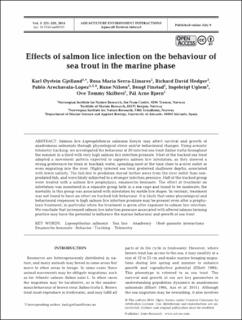| dc.contributor.author | Gjelland, Karl Øystein | |
| dc.contributor.author | Serra-Llinares, Rosa Maria | |
| dc.contributor.author | Hedger, Richard David | |
| dc.contributor.author | Arechavala-Lopez, Pablo | |
| dc.contributor.author | Nilsen, Rune | |
| dc.contributor.author | Finstad, Bengt | |
| dc.contributor.author | Uglem, Ingebrigt | |
| dc.contributor.author | Skilbrei, Ove Tommy | |
| dc.contributor.author | Bjørn, Pål Arne | |
| dc.date.accessioned | 2014-08-01T11:23:21Z | |
| dc.date.accessioned | 2023-06-19T11:53:18Z | |
| dc.date.available | 2014-08-01T11:23:21Z | |
| dc.date.available | 2023-06-19T11:53:18Z | |
| dc.date.issued | 2014 | |
| dc.identifier.citation | Aquaculture Environment Interactions 2014, 5:221-233 | en_US |
| dc.identifier.issn | 1869-215X | |
| dc.identifier.uri | https://hdl.handle.net/11250/3072057 | |
| dc.description.abstract | Salmon lice Lepeophtheirus salmonis Krøyer may affect survival and growth of
anadromous salmonids through physiological stress and/or behavioural changes. Using acoustic
telemetry tracking, we investigated the behaviour of 30 infected sea trout Salmo trutta throughout
the summer in a fjord with very high salmon lice infection pressure. Most of the tracked sea trout
adopted a movement pattern expected to suppress salmon lice infestation, as they showed a
strong preference for fresh or brackish water, spending most of the time close to a river outlet or
even migrating into the river. Highly infested sea trout preferred shallower depths, associated
with lower salinity. The fish lost to predation stayed further away from the river outlet than nonpredated
fish, and were likely subjected to a stronger infection pressure. Half of the tracked group
were treated with a salmon lice prophylaxis, emamectin benzoate. The effect of treatment on
infestation was monitored in a separate group held in a sea cage and found to be moderate; the
mortality in this group was associated with infestation by motile lice stages. In contrast, treatment
was not found to have an effect on tracked fish behaviour. It is likely that some physiological and
behavioural responses to high salmon lice infection pressure may be present even after a prophylaxis
treatment, in particular when the treatment is given after exposure to salmon lice infection.
We conclude that increased salmon lice infection pressure associated with altered salmon farming
practice may have the potential to influence the marine behaviour and growth of sea trout.
Lepeoptheirus salmonis · Sea lice · Anadromy · Host–parasite interactions ·
Emamectin benzoate · Behavior · Tracking · Telemetry | en_US |
| dc.language.iso | eng | en_US |
| dc.rights | Navngivelse 4.0 Internasjonal | * |
| dc.rights.uri | http://creativecommons.org/licenses/by/4.0/deed.no | * |
| dc.subject | Lepeoptheirus salmonis | en_US |
| dc.subject | Sea lice | en_US |
| dc.subject | Anadromy | en_US |
| dc.subject | Host–parasite interactions | en_US |
| dc.subject | Emamectin benzoate | en_US |
| dc.subject | Behavior | en_US |
| dc.subject | Tracking | en_US |
| dc.subject | Telemetry | en_US |
| dc.title | Effects of salmon lice infection on the behaviour of sea trout in the marine phase | en_US |
| dc.type | Peer reviewed | en_US |
| dc.date.updated | 2014-08-01T11:23:22Z | |
| dc.description.version | publishedVersion | en_US |
| dc.rights.holder | © 2014 The Authors | en_US |
| dc.subject.nsi | VDP::Matematikk og Naturvitenskap: 400::Zoologiske og botaniske fag: 480 | en_US |
| dc.source.pagenumber | 463-469 | en_US |
| dc.source.volume | 5 | en_US |
| dc.source.journal | Aquaculture Environment Interactions | en_US |
| dc.identifier.doi | 10.3354/aei00105 | |
| dc.identifier.cristin | 1144976 | |
| dc.relation.project | Norges forskningsråd: 160022 | en_US |
| dc.relation.project | Andre: The Norwegian Food Safety Authority | en_US |

